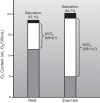Regulation of increased blood flow (hyperemia) to muscles during exercise: a hierarchy of competing physiological needs
- PMID: 25834232
- PMCID: PMC4551211
- DOI: 10.1152/physrev.00035.2013
Regulation of increased blood flow (hyperemia) to muscles during exercise: a hierarchy of competing physiological needs
Abstract
This review focuses on how blood flow to contracting skeletal muscles is regulated during exercise in humans. The idea is that blood flow to the contracting muscles links oxygen in the atmosphere with the contracting muscles where it is consumed. In this context, we take a top down approach and review the basics of oxygen consumption at rest and during exercise in humans, how these values change with training, and the systemic hemodynamic adaptations that support them. We highlight the very high muscle blood flow responses to exercise discovered in the 1980s. We also discuss the vasodilating factors in the contracting muscles responsible for these very high flows. Finally, the competition between demand for blood flow by contracting muscles and maximum systemic cardiac output is discussed as a potential challenge to blood pressure regulation during heavy large muscle mass or whole body exercise in humans. At this time, no one dominant dilator mechanism accounts for exercise hyperemia. Additionally, complex interactions between the sympathetic nervous system and the microcirculation facilitate high levels of systemic oxygen extraction and permit just enough sympathetic control of blood flow to contracting muscles to regulate blood pressure during large muscle mass exercise in humans.
Copyright © 2015 the American Physiological Society.
Figures
























Similar articles
-
Disparity in regional and systemic circulatory capacities: do they affect the regulation of the circulation?Acta Physiol (Oxf). 2010 Aug;199(4):393-406. doi: 10.1111/j.1748-1716.2010.02125.x. Epub 2010 Mar 25. Acta Physiol (Oxf). 2010. PMID: 20345408 Free PMC article. Review.
-
Compensatory vasodilatation during hypoxic exercise: mechanisms responsible for matching oxygen supply to demand.J Physiol. 2012 Dec 15;590(24):6321-6. doi: 10.1113/jphysiol.2012.242396. Epub 2012 Sep 17. J Physiol. 2012. PMID: 22988134 Free PMC article. Review.
-
Partial neuromuscular blockade in humans enhances muscle blood flow during exercise independently of muscle oxygen uptake and acetylcholine receptor blockade.Am J Physiol Regul Integr Comp Physiol. 2009 Apr;296(4):R1106-12. doi: 10.1152/ajpregu.90477.2008. Epub 2009 Feb 4. Am J Physiol Regul Integr Comp Physiol. 2009. PMID: 19193948
-
Muscle blood flow, hypoxia, and hypoperfusion.J Appl Physiol (1985). 2014 Apr 1;116(7):852-7. doi: 10.1152/japplphysiol.00620.2013. Epub 2013 Jul 25. J Appl Physiol (1985). 2014. PMID: 23887898 Free PMC article. Review.
-
Local control of skeletal muscle blood flow during exercise: influence of available oxygen.J Appl Physiol (1985). 2011 Dec;111(6):1527-38. doi: 10.1152/japplphysiol.00895.2011. Epub 2011 Sep 1. J Appl Physiol (1985). 2011. PMID: 21885800 Free PMC article. Review.
Cited by
-
Does sympathetic vasoconstriction contribute to metabolism: Perfusion matching in exercising skeletal muscle?Front Physiol. 2022 Sep 12;13:980524. doi: 10.3389/fphys.2022.980524. eCollection 2022. Front Physiol. 2022. PMID: 36171966 Free PMC article. Review.
-
Immediate Effect of Cryo-Compression Therapy on Biomechanical Properties and Perfusion of Forearm Muscles in Mixed Martial Arts Fighters.J Clin Med. 2024 Feb 19;13(4):1177. doi: 10.3390/jcm13041177. J Clin Med. 2024. PMID: 38398489 Free PMC article.
-
Is There an Exercise-Intensity Threshold Capable of Avoiding the Leaky Gut?Front Nutr. 2021 Mar 8;8:627289. doi: 10.3389/fnut.2021.627289. eCollection 2021. Front Nutr. 2021. PMID: 33763441 Free PMC article. Review.
-
The role of endothelin A receptors in peripheral vascular control at rest and during exercise in patients with hypertension.J Physiol. 2020 Jan;598(1):71-84. doi: 10.1113/JP279077. Epub 2019 Dec 9. J Physiol. 2020. PMID: 31705661 Free PMC article.
-
TRPV1 and BDKRB2 receptor polymorphisms can influence the exercise pressor reflex.J Physiol. 2018 Nov;596(21):5135-5148. doi: 10.1113/JP276526. Epub 2018 Sep 19. J Physiol. 2018. PMID: 30206938 Free PMC article.
References
-
- Andersen P, Adams RP, Sjogaard G, Thorboe A, Saltin B. Dynamic knee extension as model for study of isolated exercising muscle in humans. J Appl Physiol 59: 1647–1653, 1985. - PubMed
Publication types
MeSH terms
Substances
Grants and funding
LinkOut - more resources
Full Text Sources
Other Literature Sources
Medical

